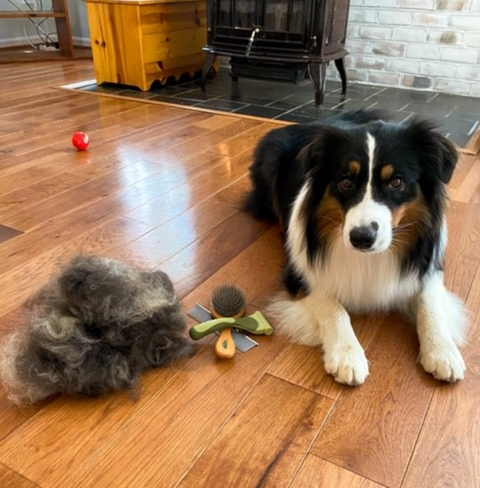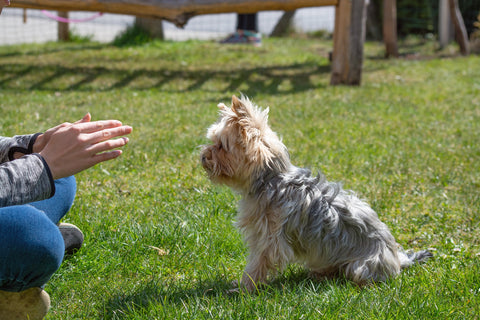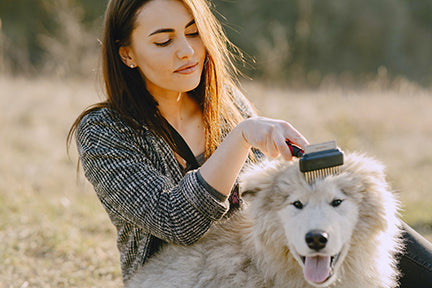Some of you may have tuned into the Mondays with Marty Facebook Live we did on July 27th where we talked about grooming. If you didn’t, you should check it out! We decided to follow up with some written details on the tools I like to use with Marty to give you a closer look.
The first tool I like to use is a standard brush. Through practice, I have found Marty’s coat will get small knots in it, like people hair, and that shedding tools aren’t great for removing knots. By starting with a standard brush, I can work out the small knots and much of the dirt and debris that may have built up in his coat since his last grooming. This brush is also not great for removing dead hair but is very effective for controlling knots and removing debris. This tool is also great for grooming the ‘feathers’ on his legs. Feathers refers to the long hairs the grow off the backs of this front legs. These can be trimmed to keep them more manageable, but I personally like the all-natural look and let them grow out. I also like to use this tool on his belly where the coat is much thinner.

Once I have finished with the hairbrush, his coat is ready for a shedding tool. Currently, a tool called the shed magic is my favorite for removing shedding hair. Marty has a thick, beautiful double coat, meaning it has two layers: a longer, coarser outer layer, and a softer, shorter, and water-resistant inner layer. When brushing him, it is important that whatever tool I use to remove dead hair gets both layers, to ensure none of the dead inner hairs get built up along his skin where they can grow bacteria and cause skin infections. So far, the shed magic has been my favorite tool for this. The teeth are hard and curved, allowing them to reach down and pull out the dead hair all the way through his coat. My goal with this tool is to go through the majority of his coat, starting at his head/neck area and working back to his britches. I don’t often use this tool on his leg feathers and will change between using this tool and the metal comb on his britches. I will go into more detail about his britches with the next tool, but the shed magic tends to have trouble getting through his britches due to the nature of his coat in that area.

Once I am through the bulk of his coat with the shed magic, I switch to a metal comb, or greyhound comb. This comb is great for getting specific areas on his body. For example, behind his ears are long, fine hairs that get greasy and are exceptionally prone to matting. The metal comb does a great job combing through those fine hairs and, if there are any mats, this comb will find them. Additionally, I like to use this comb in his britches. Most Aussies have long, crimpy hair on their britches that is coarser than the rest of their coat. This makes it much harder to get most brushes all the way through. The hairbrush will go through the coat, but it doesn’t get down to his skin and is not the best at pulling out dead hair. Plus, because the britches are so dense, it is very easy for mats and debris to hide in this area and get built up. Because of that, I like to take the metal comb slowly, and piece by piece through his britches. It is a bit tedious, but this seems to be the best way for both Marty and I to get that area combed through and cleaned of any debris and knots, while still pulling out the dead inner coat.
Generally I will not go through his whole britches all at once. Rather I’ll go through some of it, then have a go with the shed magic, then go back to the metal comb. Marty gets a little antsy if I spend too much time in one area, so I break it up a bit by switching between tools or areas.

I finish up the whole process with a coat conditioner and the hairbrush. I spray the coat conditioner over his whole body, then I work it into his coat using the hairbrush. I always give special attention to working it into his britches and the fine hairs around his ears, knowing they are more prone to mats and collecting debris. The conditioner I personally like using is Showsheen which is actually an equine product. It is great for longer lasting shine and is helps repel some debris. Plus, it’s nice that it comes in a large spray bottle considering how often I use it. As you start using a coat conditioner, err on the side of caution by spraying less rather than more, as too much can make their coats greasy.

That’s the end of grooming for Marty! The whole process takes anywhere from 20 to 40 minutes relative to how much time I spend with each tool. Generally, I compare the pile of hair I have to his quality coat and decide whether it’s time to move on or not. Amazingly, I never actually get to a point where no more hair comes out while grooming him. But as long as his coat is knot and debris free and smooth and shiny, I know am pulling enough of the dead hair out to get through until the next session.
The one tool I neglected to mention during the grooming process is treats! Marty always get lots of treats before, during, and after getting groomed to help him associate grooming with something positive! We will be doing this almost weekly for the rest of his life, so it is important for both Marty and I that it is a positive experience.
As a final note, I am also constantly looking for new and better tools. I like all the aforementioned tools, but I am always looking for something that might work better. Happy grooming and if you have any questions, please ask!
























